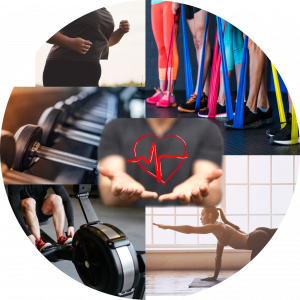
Research shows there are huge physical and mental health benefits from being physically active. It can help reduce symptoms of depression and anxiety, it can help prevent/protect against cancers, heart disease and diabetes, as well as improve general well-being. It can also be beneficial during and after treatment for cancer. In short, being physically active is great for us!
Did you know our lifestyles are becoming more sedentary? And evidence shows higher amounts of sedentary behaviours are associated with increased heart disease, cancers and diabetes?
How much time do you spend sitting every day?
Types of activity
Cardiovascular activity (aerobic exercise); This type of activity increases heart rate and helps improve cardio respiratory fitness.
And
Resistance training (strengthening exercise); this type of exercise improves strength and muscle size.
Intensity of activity
These are typically referred to as:
Moderate: This level of exercise/physical activity will raise your heart rate, make you breathe faster and feel warmer. One way to know you are working at this level of intensity is if you can still talk, but not sing.
Vigorous: This level of activity makes you breathe hard and fast. You know you are working at this lever of intensity if you can’t say more than a few words without pausing for breath.
Very vigorous: This level of activity/exercise is done in short bursts of maximum effort, broken up with rest. It’s also referred to as High Intensity Interval Training (HIIT).
Activity ideas
Very vigorous intensity:
lifting heavy weights
circuit training
sprinting up hills
interval running
spinning classes

Strength/moderate intensity:
To get the benefits from these exercises, you should do them to the point where you need a short rest before repeating the activity:
Carrying heavy shopping bags
Yoga/Pilates
doing exercise using your own bodyweight, e.g. Push-ups
Heavy gardening

Cardio/vigorous intensity (Most moderate activities can become vigorous if you increase your effort):
Jogging or running
swimming fast
riding a bike fast
sports (like football, rugby, netball or hockey)

Cardio / Moderate intensity:
Brisk walking
water aerobics
riding a bike
dancing
Adults should do some type of physical activity every day. Any type of activity is good for you, but having a mixture of different types is best.
For general health and wellbeing, adults should get at least 150 minutes of moderate intensity activity a week OR 75 minutes of vigorous intensity activity a week (which can be done in short sessions more often across the week). Or, a mixture of both.
Adults should include resistance activities at least 2 days a week all the major muscles.
It’s good to get a mix of cardio and resistance, moderate and vigorous intensity activity across the week.
Make sure the type and intensity of your activity is appropriate for your level of fitness! Vigorous activity is not recommended for previously inactive people.

International guidelines state it is safe to be active during and after cancer treatment, but if you have cancer you should check with your doctor before starting any exercise.
Research has shown strong evidence that physical activity can help people with cancer:
reduce anxiety
improve depression
reduce fatigue
improve quality of life during and after cancer treatment
prevent or improve lymphedema (a type of swelling caused by treatment to lymph nodes)
improve general physical functioning
reduce the risk of recurrence.
Cancer affecting your bones
If you have cancer affecting your bones, you might be at risk of breaking a bone or a fracture. You should avoid putting too much stress and strain on the affected areas. Swimming, exercising in water and yoga/pilates is an excellent way of exercising without adding stress or pressure to bones.
Low immunity
Those with lower immune systems due to treatment should try to avoid exercising in public gyms. Ask your consultant when it is safe to start exercising in the gym with other people, although doesn’t mean that you cannot be active in other ways.
Peripheral Neuropathy
Some people experience loss of sensation or the feelings of pins and needles in their hands and feet during cancer treatment. Exercises you can still do while experiencing this could be using a stationary bike or some weight bearing exercises like yoga/pilates.
After certain types of surgery
After certain types of surgery, you may have to wait a little bit of time before exercising like you used to although it is best to consult with your doctor or specialist nurse about the time frame for exercising or they may be able to provide approved exercises for you.
It’s important to know that being physically active during and after cancer is extremely beneficial. But always get advice and guidance from a professional, who can help you personalise your activities, if you are worried about your abilities.
Being active in whatever way you are able is always better than not being active.
